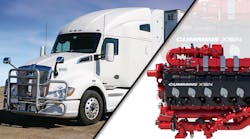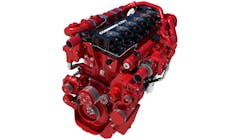LONG BEACH, California— Two-thirds of the long-haul truck market today is served by diesel-powered 15-liter engines, noted Todd Swenson, manager of global regulatory affairs at Cummins Inc. And to help fulfill immediate sustainability needs for the long-haul segment, Cummins unveiled a new 15-liter natural gas engine during the Advanced Clean Transportation (ACT) Expo here.
A team effort with the California Natural Gas Vehicle Partnership (CNGVP), the near-zero emission X15N natural gas engine will offer ratings up to 500 horsepower and 1,850 lb.-ft. of torque, enabling fleets to achieve powerful performance when hauling 80,000-lb. loads or more. The range of a truck with a Cummins X15N 15-liter natural gas engine will allow for at least 750 miles of driving between refueling.
These days, natural gas solutions have been referred to as a “bridge” technology along the journey to zero-emission freight operations. But for Cummins, renewable natural gas (RNG) in the commercial vehicle space is here to stay for the next 10 to 15 years.
See also: Class 8 natural gas retail sales gain momentum, report finds
“Some call natural gas technologies a bridge technology. We don’t really like the word, but we’ll go along with it,” Puneet Jhawar, general manager of global natural gas at Cummins, told FleetOwner. “We just think that the bridge is a lot longer than some people believe. That’s why we are spending a tremendous amount of money building the product as well as the capability for our customers.”
One of the misconceptions surrounding natural gas as a power source is that the range of the vehicle could be problematic for fleets returning back to base. Jhawar pointed out, however, that the range of natural gas vehicles is almost on par with diesel.
“If you look at well to wheel, using renewable natural gas is actually better,” Jhawar said. “We are investing money in all technologies because we know that it’s not just one technology that gets us there, it’s a combination of technologies depending on application.”
CNGVP, an alliance of air-quality, transportation and energy agencies, vehicle and engine manufacturers, fuel providers, transit and refuse hauler associations, and other stakeholders, is interested in increasing and strengthening the deployment of near-zero emission (NZE) natural gas vehicles throughout California.
In tandem with the announcement, CNGVP announced that in 2021 the energy weighted carbon intensity value of all-natural gas used for transportation fuel in California was below zero at negative 33.36 gCO2e/MJ, according to recently released data from the California Air Resources Board’s (CARB) Low Carbon Fuel Standard (LCFS) program.
“In California, a heavy-duty truck with a Cummins 15-liter natural gas engine can provide the greatest GHG emissions benefit compared to all commercially available options, all while significantly outperforming diesel trucks on a cost-per-mile basis,” noted Swenson, who also serves as president of CNGVP. “Cummins has received significant fleet customer interest in the X15N, as it provides a very viable and competitive option to reduce the environmental impact for traditional over-the-road long-haul applications.”Fleets today are also looking for additional ways to save money on fuel costs, particularly as diesel costs have reached record highs, increasing some 20% nationwide. On average, the pump price for natural gas in 2021 was $2.32 per diesel gallon equivalent (DGE) for private fuelers and $2.57 per DGE at public fueling stations, with diesel fuel averaging 25% higher on a DGE basis. In 2022, the national average price of diesel has increased to more than $5 per gallon.
The Cummins X15N 15-liter natural gas engine will have a similar physical footprint as its existing 12-liter natural gas engine, and Cummins is actively working with major OEMs to integrate the engine. As an additional benefit, the Cummins X15N natural gas engine weighs less than the existing 12-liter natural gas engine and about 500 lb. less than a comparable diesel engine.
In 2021, about 98% of natural gas used for transportation in California came from methane emitted by renewable sources, including landfill waste, livestock manure, wastewater treatment plants, food and green waste, dead trees, and agricultural waste.
Growth in the volume of swine and dairy gas being reported into California’s LCFS program is the main factor continuing to drive the carbon intensity value of natural gas transportation fuel lower. With new production facilities continuing to come online, California-produced RNG is anticipated to have an average energy weighted carbon intensity of negative 101.74 gCO2e/MJ by January 2024.





